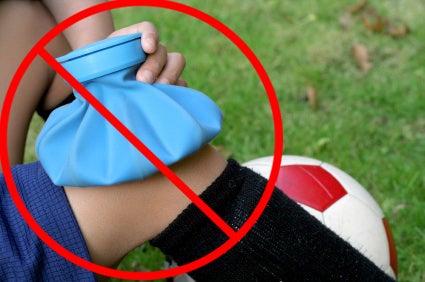Rethinking R.I.C.E. for Sprains and the Like
Russ Chastain 09.22.17

I recently stumbled across a post on Spartan Life about rethinking the R.I.C.E. (rest, ice, compression, elevation) treatment for sprains and other such ailments, and it gave me pause. The reason? My shoulder had been giving me a lot of trouble; so much that it severely restricted my movement with that arm, and at times a deep, dull ache would pretty much permeate my entire being. My only relief was found in keeping it still and icing it down as the weeks slowly passed before my doctor’s appointment.
The fact that icing brought my only relief is what caused me to take note of this article. It is applicable to anyone with a physically active lifestyle, and the outdoors life is just that.
The R.I.C.E. acronym came into being with “The Sportsmedicine Book,” a best-selling 1978 book by Gabe Mirkin, M.D.
Tweak your ankle, throw out your back, strain your rotator cuff, or upset any other soft tissue during exercise? R.I.C.E. it right away! If no ice bag is available, slap a bag of frozen vegetables onto your aggrieved part. By icing an injury within the first golden hour of sustaining it, you’re virtually guaranteed of not only reducing pain but speeding recovery. Ditto for rest—taking time off to let things settle down will prevent further damage and also expedite healing. Everybody knows this, right?
But what if R.I.C.E. is wrong?
The article goes on to say that while ice reduces inflammation, it’s a temporary fix; tissues will inflame once more after they warm back up. And some evidence is offered that icing delays the release of hormones which trigger the healing of damaged tissue.
To combat the well-entrenched (but apparently wrong) notion of icing everything, a book entitled “Iced! The Illusionary Treatment Option” has been written by athletic trainer Gary Reinl — and R.I.C.E. coiner Gabe Mirkin even penned the foreword in its second edition.
And even the “rest” portion is now called into question:
As for why keeping injured tissues moving works better than immobilizing them, the exact mechanisms await further research. “We don’t understand everything about this yet,” Reinl concedes, “but we do know that stillness is the enemy. If you remain still, everything shrinks and atrophies—your muscles, bones, ligaments, everything.”
Careful muscle activation, by contrast, has the opposite effect. Contractions around lymphatic vessels clear waste and increase blood circulation to damaged tissues. This, in turn, increases deposition of replacement collagen and boosts the “remodeling” process that pulls apart scar tissue and makes it functional.
To get back to my own experience, after a cortisone shot eased a portion of my shoulder pain, I was able to begin using that arm once again — slowly. Weeks later, my range of motion is still restricted, but much less than it was… and at least some of my present restriction is no doubt due to all of the rest I gave it while waiting for it to improve. Resting it eased some of my pain but had negative long-term effects.
So if R.I.C.E. is no longer the answer, what’s a better strategy for expediting your return to the field of play? Reinl, for his part, believes the answer lies in a new acronym: A.R.I.T.A.—active recovery is the answer.
There are exceptions, of course—you may have no choice but to immobilize a limb, say, with a compound fracture. But for most garden-variety sports injuries, Reinl suggests resisting the urge to ice away your pain and plop down on the couch for days. Instead, let your pain level be your guide and keep on moving as much or as little as your mending body allows.
Sounds like good advice, whether you’re playing sports or hiking in the back country.